Abstract
OBJECTIVE--To evaluate and describe the clinical course of angio-oedema reactions induced by angiotensin converting enzyme inhibitors. DESIGN AND METHODS--All reports of angio-oedema reactions associated with angiotensin converting enzyme inhibitors submitted to Swedish Adverse Reactions Advisory Committee were reviewed and the clinical courses summarised. Numbers of cases judged to be induced by angiotensin converting enzyme inhibitors were related to their annual usage, estimated from total sales of defined daily doses, as well as to the estimated number of new patients. All cases of angio-oedema associated with angiotensin converting enzyme inhibitors reported to the World Health Organisation's international drug information system were also summarised. RESULTS--36 of the 38 reported cases in Sweden between 1981 and 1990 were judged to be related to angiotensin converting enzyme inhibitors. During 1981 through 1990, altogether 1309 cases of angio-oedema associated with angiotensin converting enzyme inhibitors were registered with the international drug information system. The incidence of reported cases of angio-oedema increased largely in parallel with the increased sales (usage) of angiotensin converting enzyme inhibitors. Of the 36 Swedish patients, 77% experienced the reaction within the first three weeks after starting treatment. 10 patients needed hospitalisation, two of whom had life threatening laryngeal obstruction. With one exception all 36 patients were free of symptoms within one week after discontinuing the drug. CONCLUSIONS--Angio-oedema induced by angiotensin converting enzyme inhibitors is a rare but potentially life threatening reaction, which in most instances occurs shortly after the start of treatment. Any patient in whom the reaction is suspected should have the treatment interrupted and, if necessary, be admitted for observation.
Full text
PDF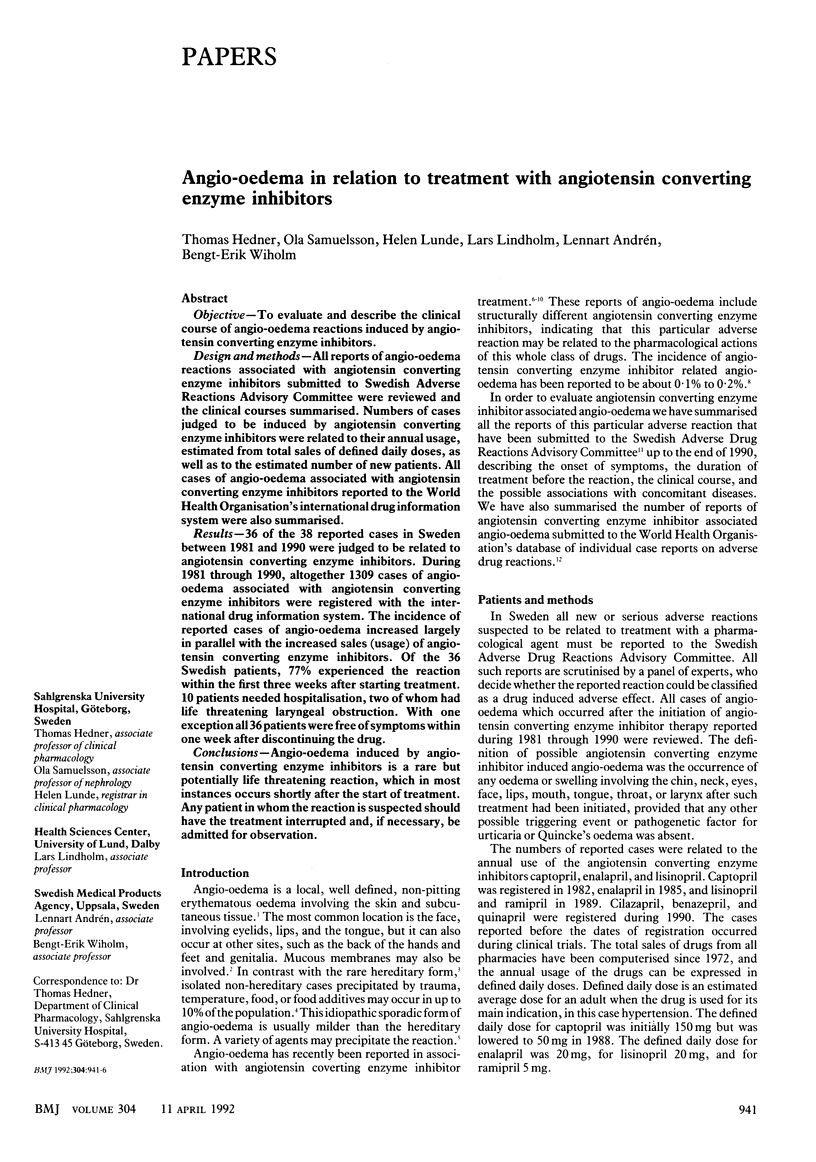
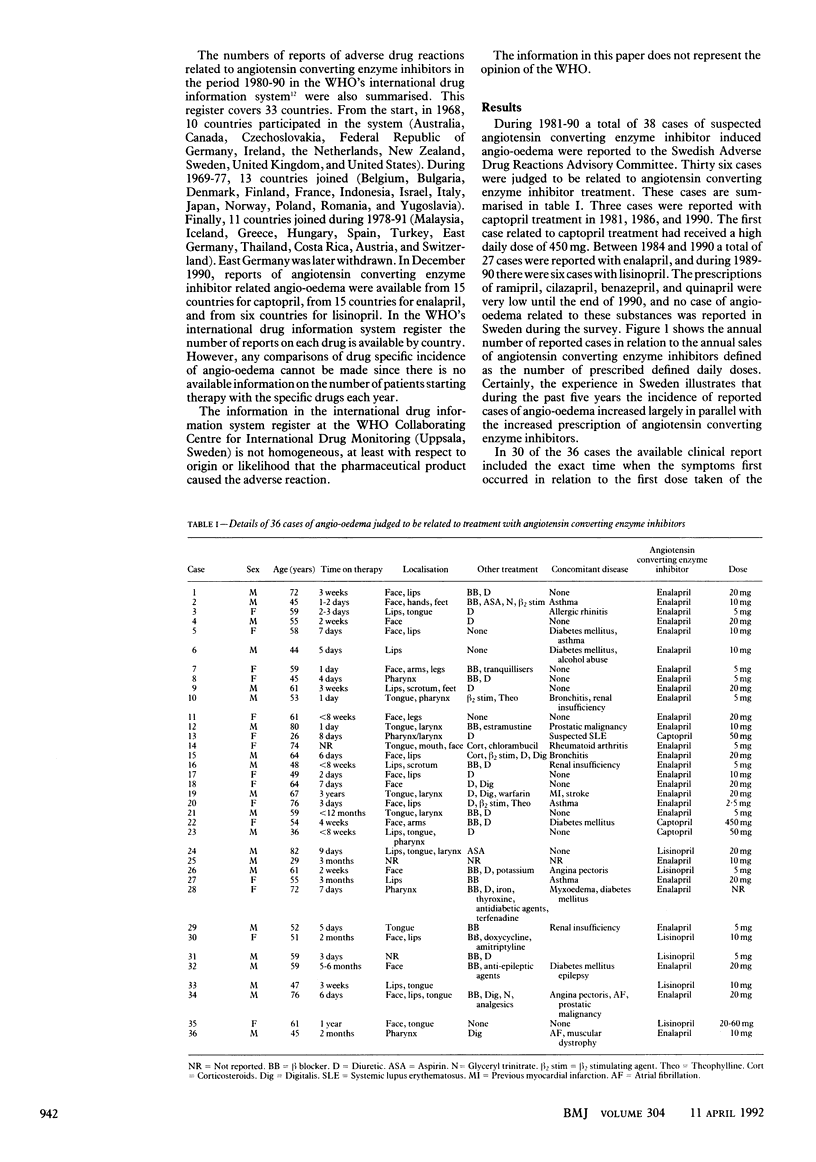
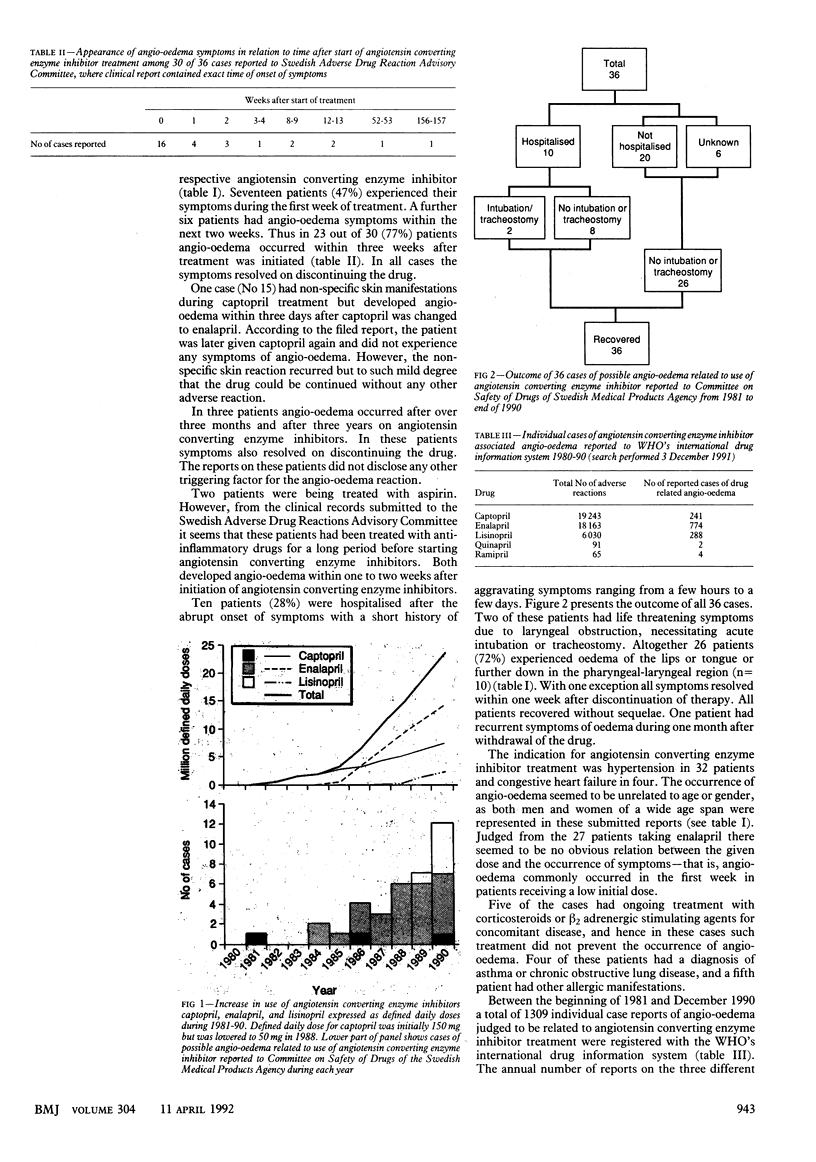
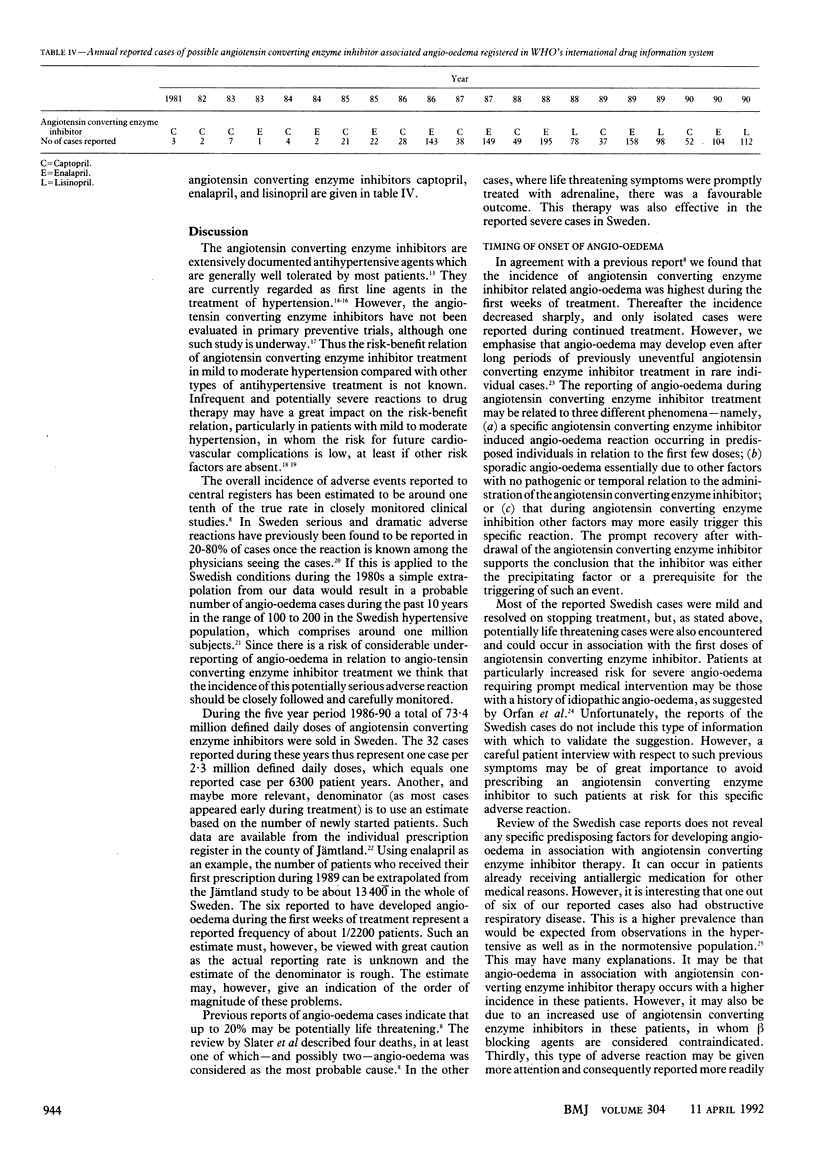
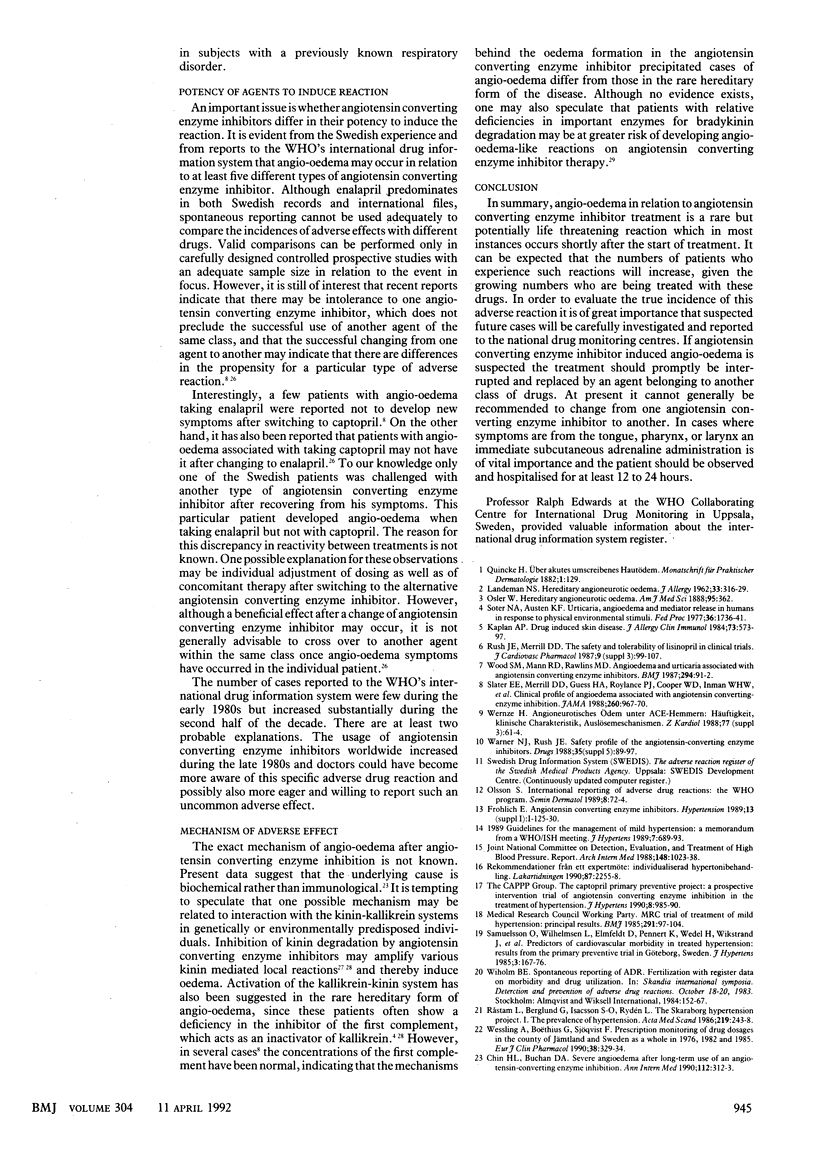
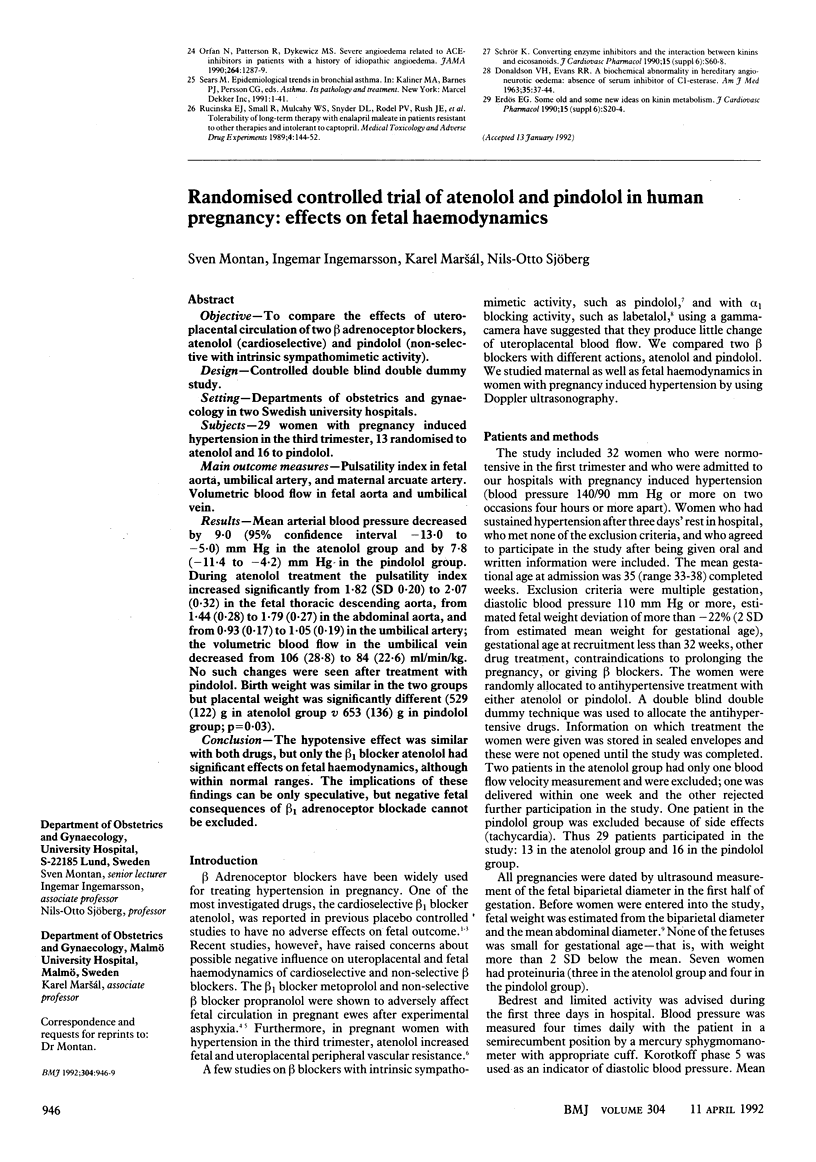
Selected References
These references are in PubMed. This may not be the complete list of references from this article.
- Chin H. L., Buchan D. A. Severe angioedema after long-term use of an angiotensin-converting enzyme inhibitor. Ann Intern Med. 1990 Feb 15;112(4):312–313. doi: 10.7326/0003-4819-112-4-312_2. [DOI] [PubMed] [Google Scholar]
- DONALDSON V. H., EVANS R. R. A BIOCHEMICAL ABNORMALITY IN HEREDIATRY ANGIONEUROTIC EDEMA: ABSENCE OF SERUM INHIBITOR OF C' 1-ESTERASE. Am J Med. 1963 Jul;35:37–44. doi: 10.1016/0002-9343(63)90162-1. [DOI] [PubMed] [Google Scholar]
- Erdös E. G. Some old and some new ideas on kinin metabolism. J Cardiovasc Pharmacol. 1990;15 (Suppl 6):S20–S24. [PubMed] [Google Scholar]
- Kaplan A. P. Drug-induced skin disease. J Allergy Clin Immunol. 1984 Oct;74(4 Pt 2):573–579. doi: 10.1016/0091-6749(84)90109-x. [DOI] [PubMed] [Google Scholar]
- LANDERMAN N. S. Hereditary angioneurotic edema. I. Case reports and review of the literature. J Allergy. 1962 Jul-Aug;33:316–329. doi: 10.1016/0021-8707(62)90031-x. [DOI] [PubMed] [Google Scholar]
- Olsson S. International reporting of adverse drug reactions: the WHO program. Semin Dermatol. 1989 Jun;8(2):72–74. [PubMed] [Google Scholar]
- Orfan N., Patterson R., Dykewicz M. S. Severe angioedema related to ACE inhibitors in patients with a history of idiopathic angioedema. JAMA. 1990 Sep 12;264(10):1287–1289. [PubMed] [Google Scholar]
- Rucinska E. J., Small R., Mulcahy W. S., Snyder D. L., Rodel P. V., Rush J. E., Smith R. D., Walker J. F., Irvin J. D. Tolerability of long term therapy with enalapril maleate in patients resistant to other therapies and intolerant to captopril. Med Toxicol Adverse Drug Exp. 1989 Mar-Apr;4(2):144–152. doi: 10.1007/BF03259909. [DOI] [PubMed] [Google Scholar]
- Rush J. E., Merrill D. D. The safety and tolerability of lisinopril in clinical trials. J Cardiovasc Pharmacol. 1987;9 (Suppl 3):S99–107. doi: 10.1097/00005344-198700003-00023. [DOI] [PubMed] [Google Scholar]
- Råstam L., Berglund G., Isacsson S. O., Rydén L. The Skaraborg hypertension project. I. The prevalence of hypertension. Acta Med Scand. 1986;219(3):243–248. doi: 10.1111/j.0954-6820.1986.tb03307.x. [DOI] [PubMed] [Google Scholar]
- Samuelsson O., Wilhelmsen L., Elmfeldt D., Pennert K., Wedel H., Wikstrand J., Berglund G. Predictors of cardiovascular morbidity in treated hypertension: results from the primary preventive trial in Göteborg, Sweden. J Hypertens. 1985 Apr;3(2):167–176. doi: 10.1097/00004872-198504000-00010. [DOI] [PubMed] [Google Scholar]
- Schrör K. Converting enzyme inhibitors and the interaction between kinins and eicosanoids. J Cardiovasc Pharmacol. 1990;15 (Suppl 6):S60–S68. [PubMed] [Google Scholar]
- Slater E. E., Merrill D. D., Guess H. A., Roylance P. J., Cooper W. D., Inman W. H., Ewan P. W. Clinical profile of angioedema associated with angiotensin converting-enzyme inhibition. JAMA. 1988 Aug 19;260(7):967–970. [PubMed] [Google Scholar]
- Soter N. A., Austen F. Urticaria, angioedema, and mediator release in humans in response to physical environmental stimuli. Fed Proc. 1977 Apr;36(5):1736–1741. [PubMed] [Google Scholar]
- Warner N. J., Rush J. E. Safety profiles of the angiotensin-converting enzyme inhibitors. Drugs. 1988;35 (Suppl 5):89–97. doi: 10.2165/00003495-198800355-00016. [DOI] [PubMed] [Google Scholar]
- Wernze H. Angioneurotisches Odem unter ACE-Hemmern: Häufigkeit, klinische Charakteristik, Auslösemechanismen. Z Kardiol. 1988;77 (Suppl 3):61–64. [PubMed] [Google Scholar]
- Wessling A., Boëthius G., Sjöqvist F. Prescription monitoring of drug dosages in the county of Jämtland and Sweden as a whole in 1976, 1982 and 1985. Eur J Clin Pharmacol. 1990;38(4):329–334. doi: 10.1007/BF00315570. [DOI] [PubMed] [Google Scholar]
- Wood S. M., Mann R. D., Rawlins M. D. Angio-oedema and urticaria associated with angiotensin converting enzyme inhibitors. Br Med J (Clin Res Ed) 1987 Jan 10;294(6564):91–92. doi: 10.1136/bmj.294.6564.91. [DOI] [PMC free article] [PubMed] [Google Scholar]


